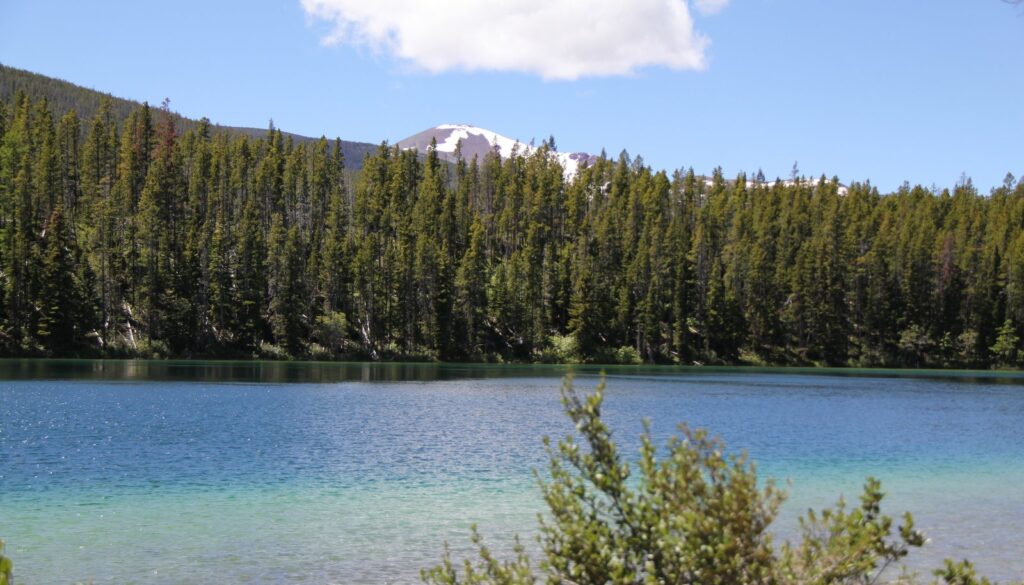A scenic view of Heart Lake in the Scapegoat Wilderness. The United States congress designated the Scapegoat Wilderness in 1972 with a total of 239,936 acres. The long northwest border of the Scapegoat Wilderness is shared with the Bob Marshall Wilderness and the massive limestone cliffs that dominate 9,204 ft Scapegoat Mountain are an extension of the “Bob’s” Chinese Wall. Elevations range from 5,000 feet on the North Fork Blackfoot River to 9,400 feet on Red Mountain; the highest peak in the Wilderness Complex. (Photo courtesy of the U.S. Forest Service via Flickr | CC-BY-SA 2.0)
The 1964 Wilderness Act celebrates its 60th anniversary today (Sept. 3rd ). Diamonds are a gift for a 60th wedding anniversary and presumably represent strength, but from a humanitarian lens diamonds have evolved to represent consumption and exploitation.
This duality resonates with the 1964 Wilderness Act’s diamond anniversary and provides an opportunity to reflect on where we are now and what the National Wilderness Preservation System—wilderness—faces moving forward.
The Wilderness Act is exceptional. Unlike the National Environmental Policy Act, which requires the government to understand the possible environmental impacts of its proposed actions, unlike the Endangered Species Act, which protects only those species close to disappearing entirely, the Wilderness Act proactively protects ecosystems by minimizing human interference. Ecosystems and organisms within Wilderness simply exist on their own evolutionary terms, sculpted by climate, weather, and wildlife.
The Wilderness Act is our promise to restrain ourselves from consuming wilderness in a way that degrades its future wildness. We experience wilderness on its terms—hiking, camping, canoeing, horseback riding, hunting, and fishing. The Wilderness Act prohibits us from developing, mechanizing, degrading, or manipulating wilderness, even with well-intentioned ideas.
Wilderness is rare. Although wilderness encompasses 150 distinct ecosystem types nationwide, wilderness comprises less than 3% of the contiguous United States, or about 5% including Alaska. Yet wilderness tempts special-interest groups. Surrendering to that temptation—creating exceptions for prohibited activities, the diamonds we exploit in wilderness—will undo the Wilderness Act. The turning point is already here.
One group teeters on the precipice of attaining a nationwide exception. The EXPLORE Act would permit rock climbers to drill metal into wilderness rock faces and leave these “fixed anchors” as permanent human footprints. One can hike without handrails, and one can climb without fixed anchors, but occasionally one must avoid a route that is otherwise too dangerous. But some climbers want their diamond! The House passed the EXPLORE Act and the Senate is considering it.
Groups are lining up behind the climbers. Utah’s Sen. Mike Lee has introduced a bill that would amend the Wilderness Act to allow bicycles—mechanized transport—in wilderness. Exceptions are a cancer that will spread if ignored. Hand gliders are mechanized like bicycles, why not them? Electric bicycles are quiet bicycles. Electric bicycles have motors, so then why not motorized bikes, too?
Some argue that recreationists are the best wilderness advocates. But if a climber only cares about wilderness so long as she can use fixed anchors, or a biker only cares about wilderness insofar as he can bike there, do these folks really care about wilderness? Or are they more enamored by the sparkly allure of a wild place to recreate with their toys?
Recreationists are hardly the only exception-seekers. Some scientists argue for installations—which the Wilderness Act prohibits—to mine data. Installations are stationary or include tracking collars that researchers and agencies shackle onto wild animals after chasing them down with helicopters. Tracking collars disorient, chafe, and sometimes even kill animals, as one researcher discovered when he found a black bear that suffocated himself trying to remove his collar. State fish and game agencies want to tinker with animal populations for hunting or fishing. These exceptions, sought in alleged pursuit of science or conservation, degrade the lives of individual animals, ignore the role of unmanipulated control groups in scientific experiments, and undermine the Wilderness Act’s mandate for untrammeled communities.
Without restraint, wilderness dies. Half of the approximately 40 wilderness-related bills introduced to the current Congress create special-interest exceptions in proposed wildernesses or amend the Wilderness Act. These exceptions allow motorized use, mechanized use, installations, and wildlife manipulation. Alternatively, these bills draw absurdly gerrymandered wilderness boundaries so although a trail physically cuts through wilderness, the trail itself is technically not wilderness, and bikes can ride on through this loophole.
When asked why a wilderness bill allows exceptions, which normalize wilderness-degrading activities, Congressional offices point to stakeholders. Stakeholders want to exploit wilderness for their diamonds, and some conservation organizations—including nationally recognizable names as well as local groups—want the nominal win of a “wilderness” designation. Perhaps these organizations fail to consider the cost to creatures and their last truly wild sanctuaries. Worse yet, perhaps these organizations understand this market and intentionally traffic in diamonds.
We strengthen laws, follow them, or undo them. Currently, special-interest groups, abetted by Congress and some conservation organizations, are slowly undoing the Wilderness Act. This undoing leads to a future where “wilderness” becomes an arbitrary title, bestowed without a critical look at ourselves and our ambitions.
Unlike those whose support is conditioned on exceptions, the best wilderness advocates understand that wilderness is where we exercise restraint—where nature evolves without intentional human interference, where humans visit without mechanization, and where we refrain from harassing wildlife and degrading their habitat. Wilderness without special-interest exceptions should be our promise to wilderness for the next 60 years.
Katie Bilodeau is the Legislative Director and Policy Analyst for Wilderness Watch, a national Wilderness organization headquartered in Missoula, Montana.

